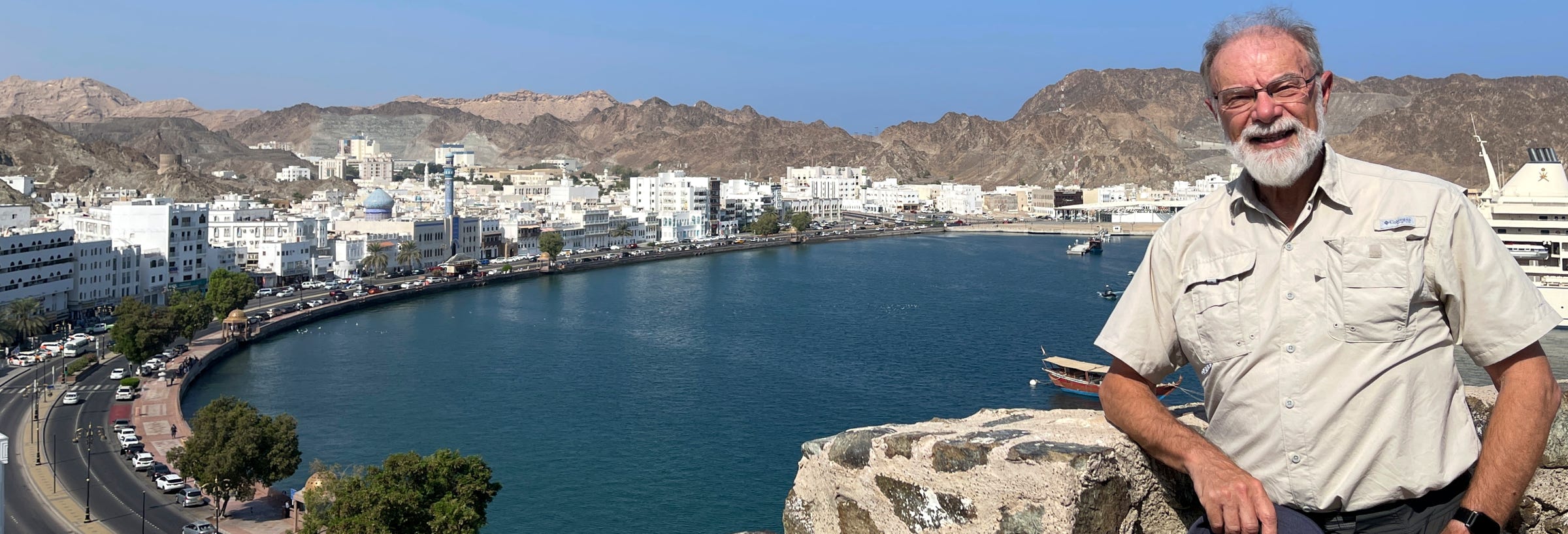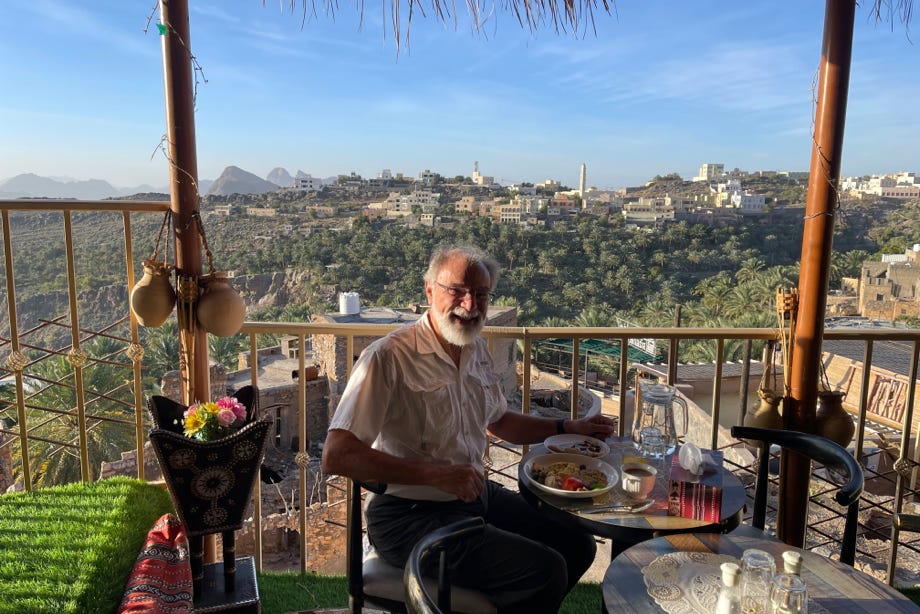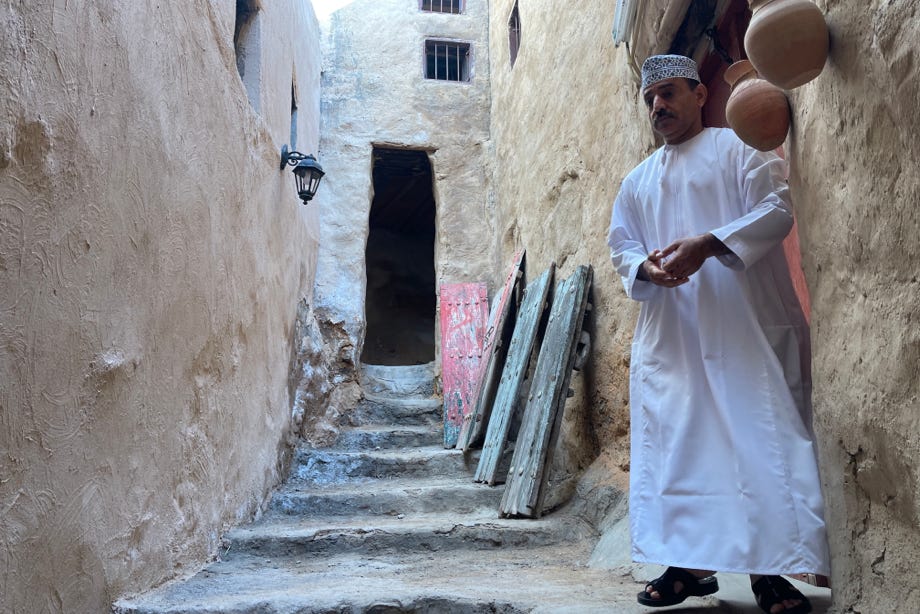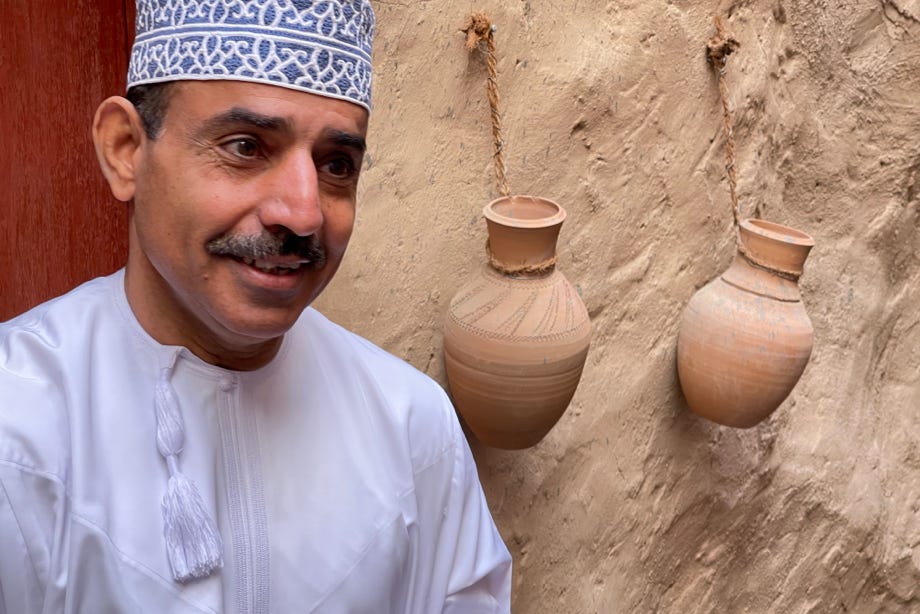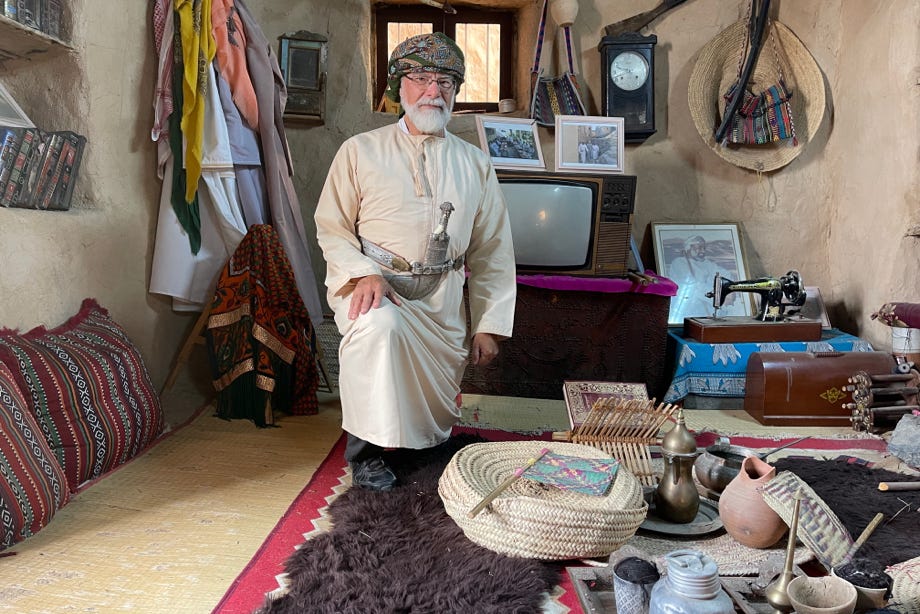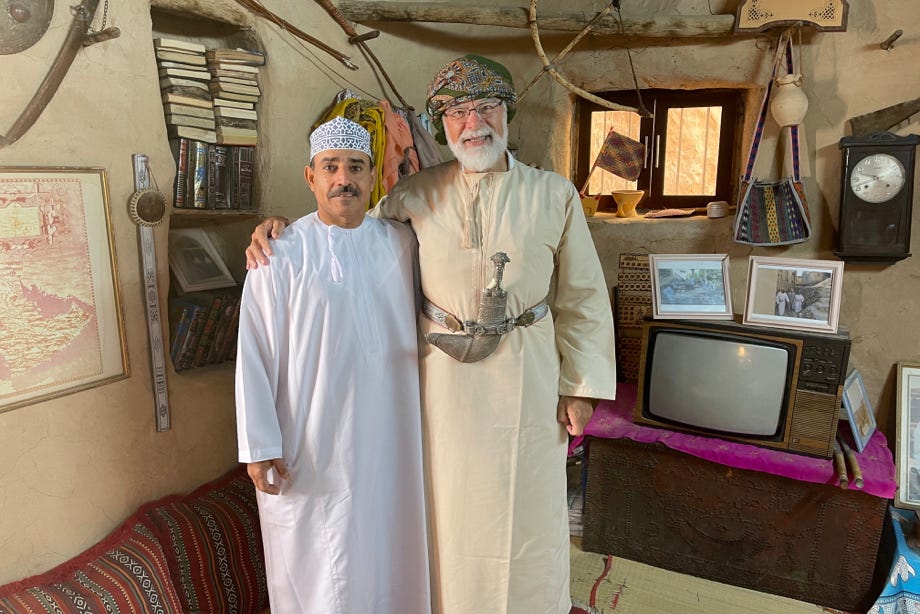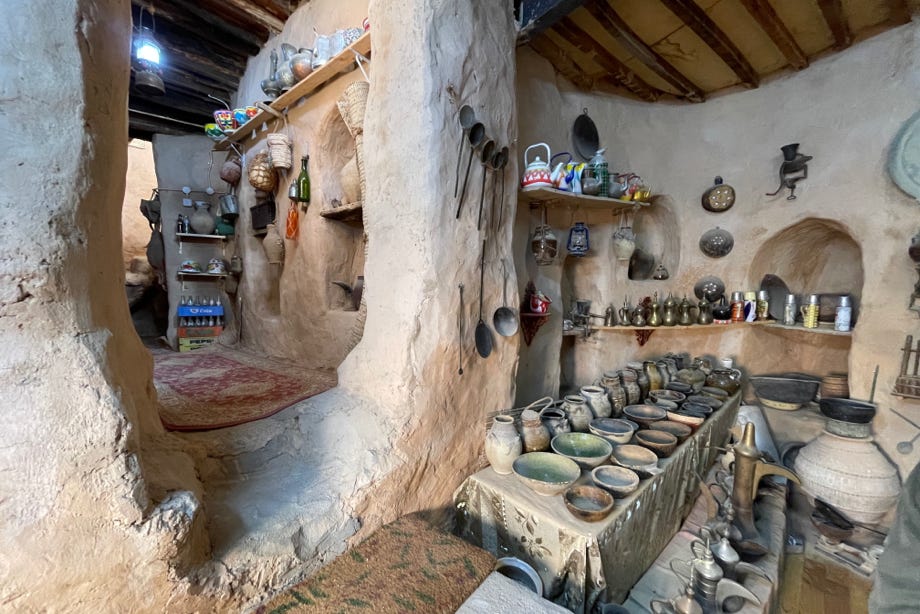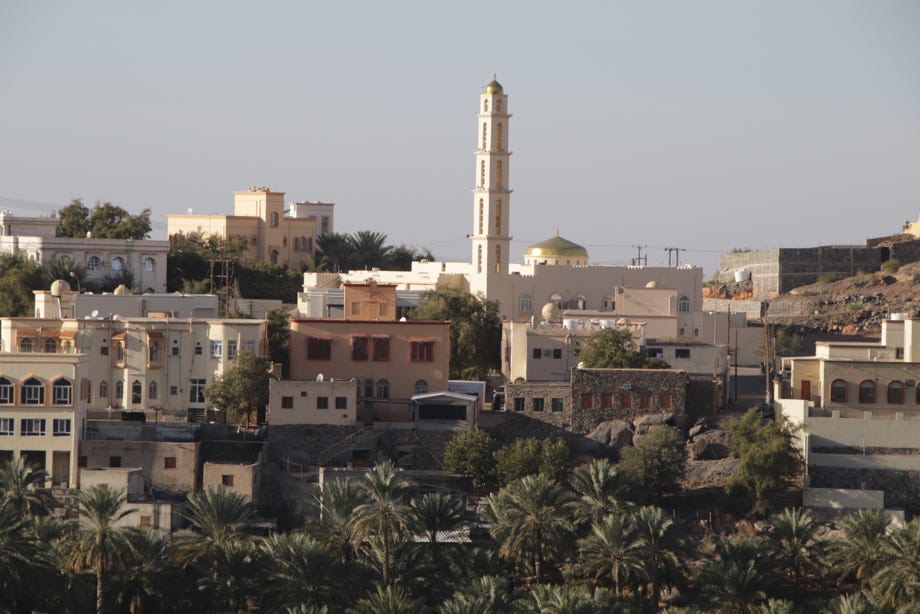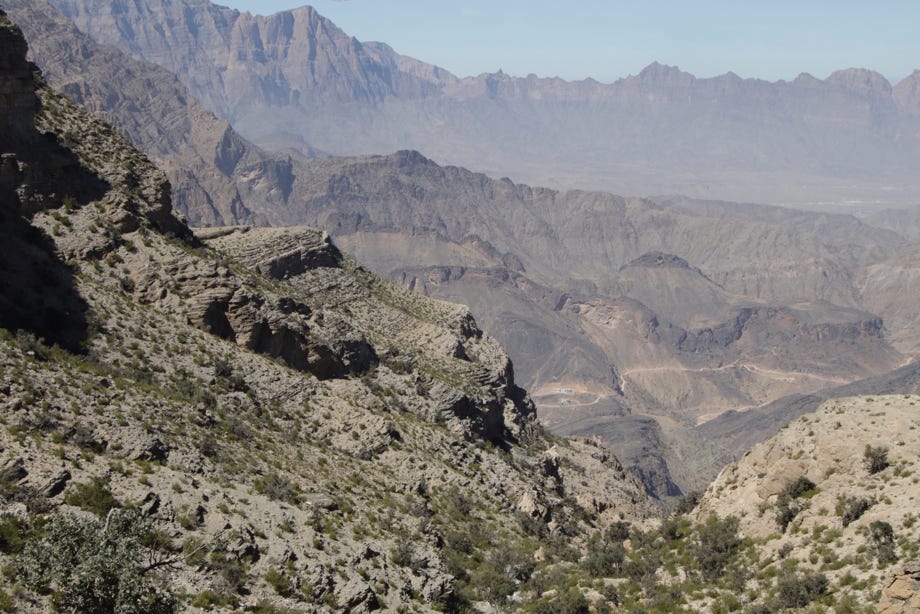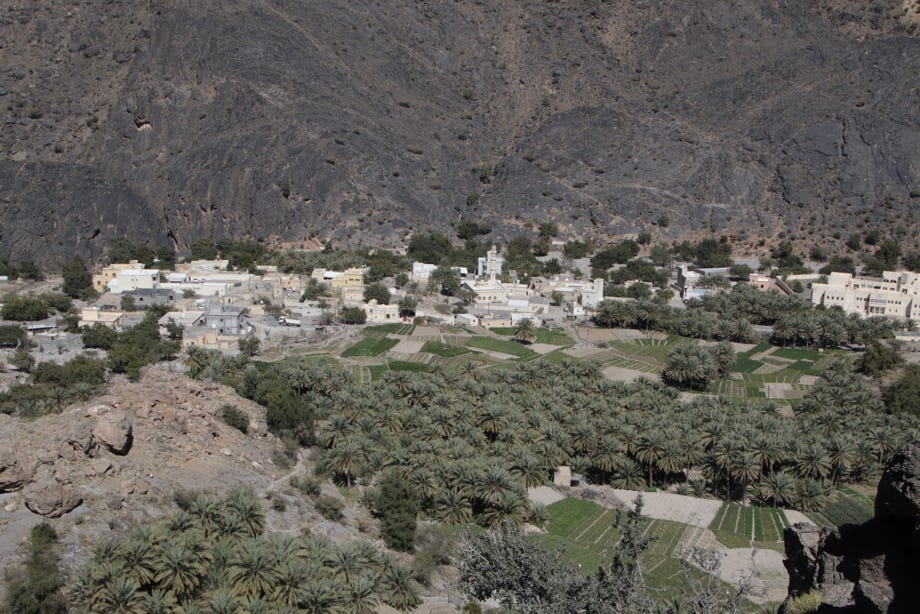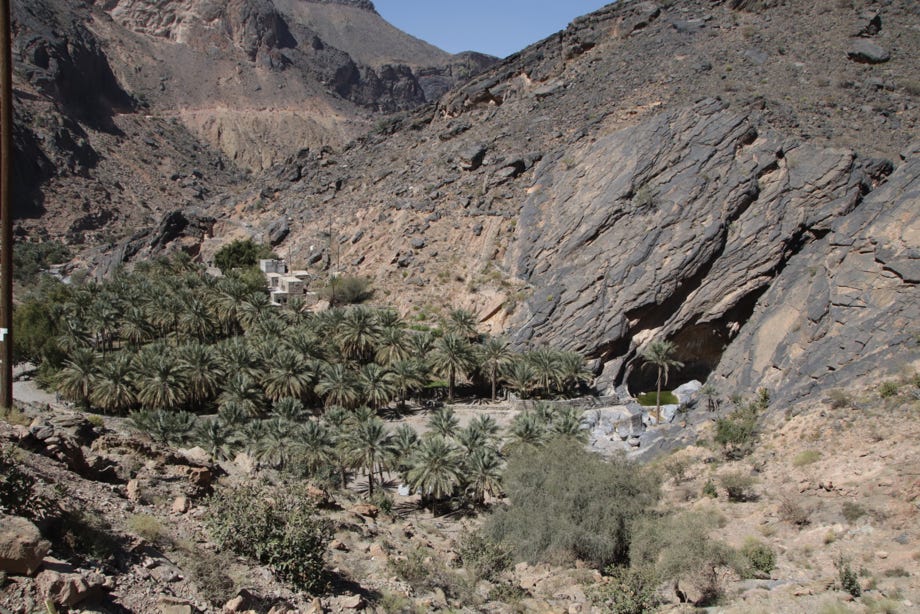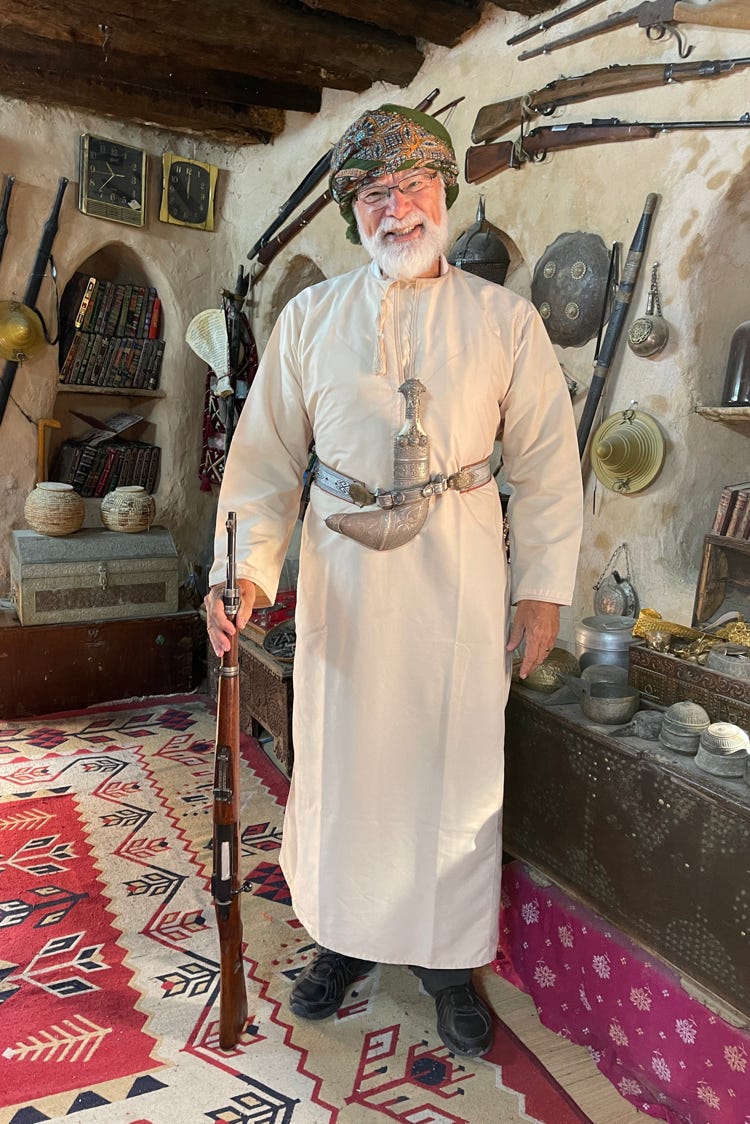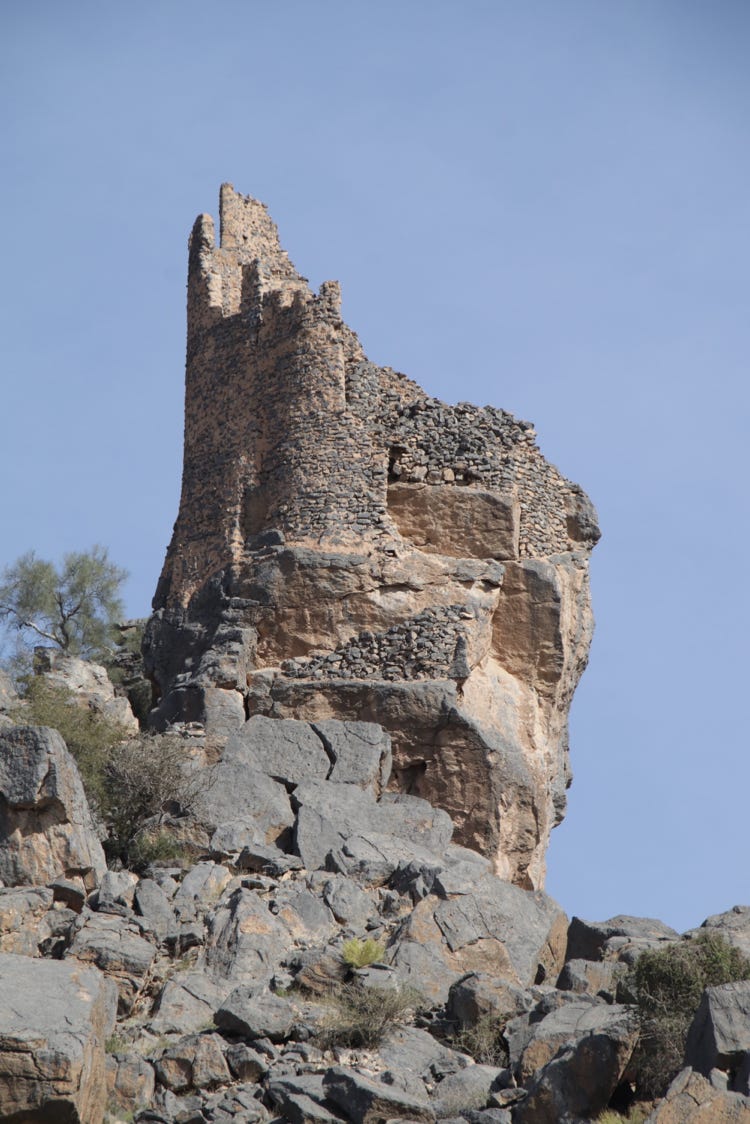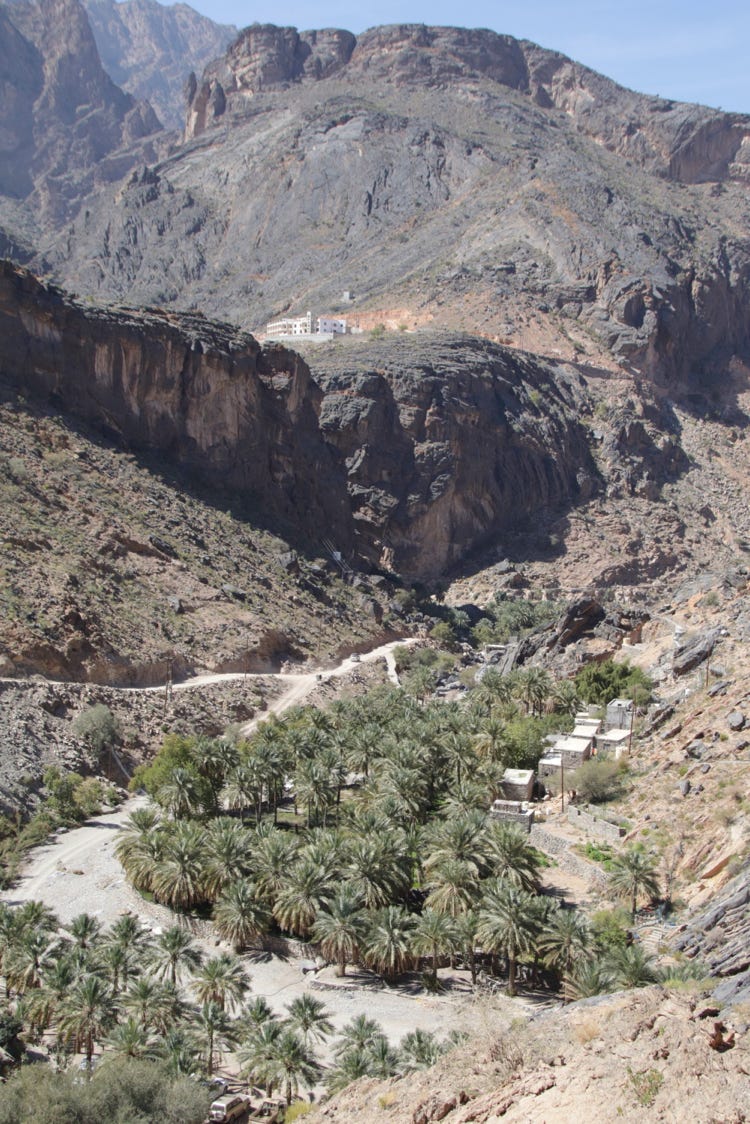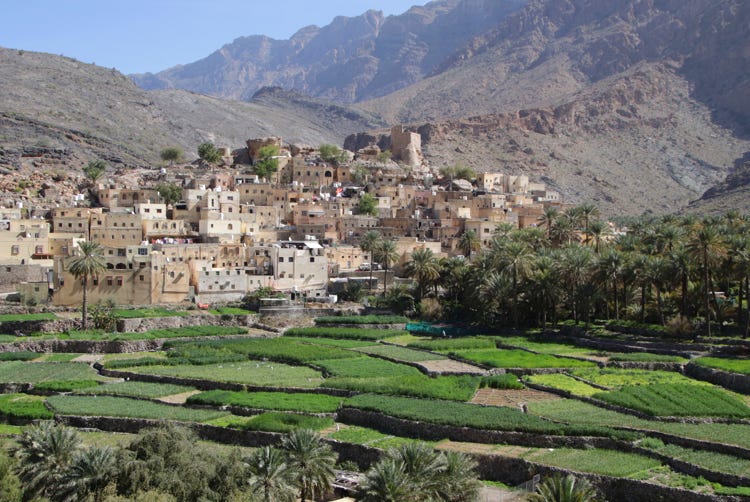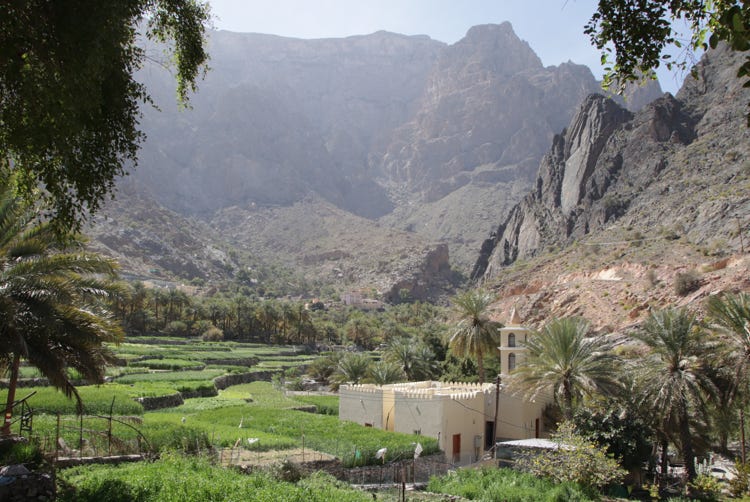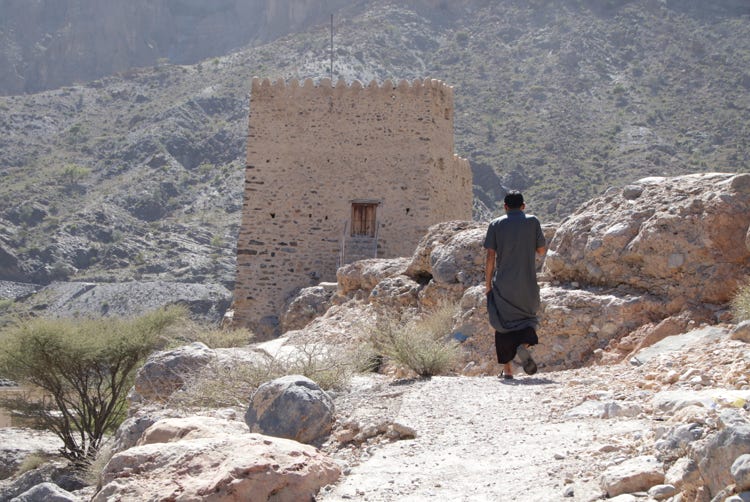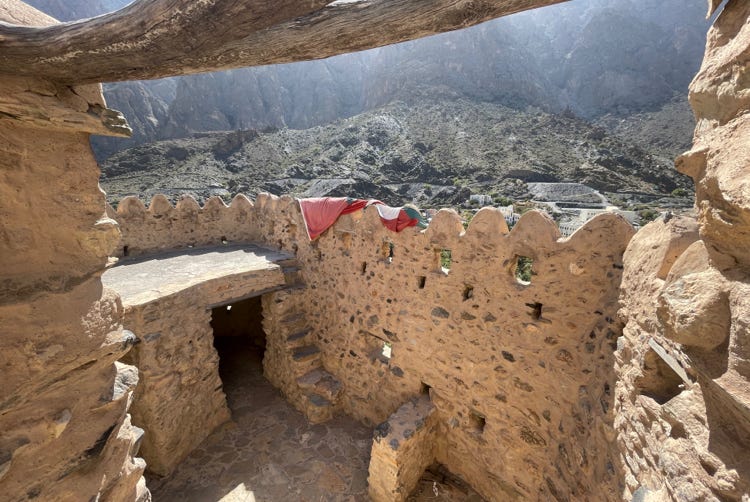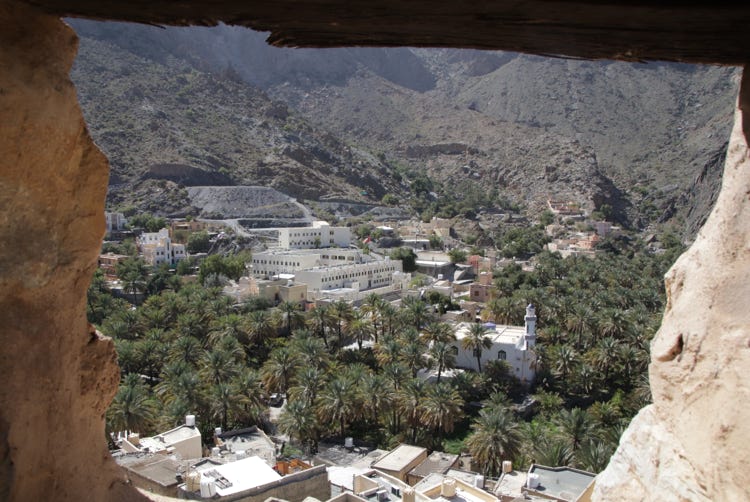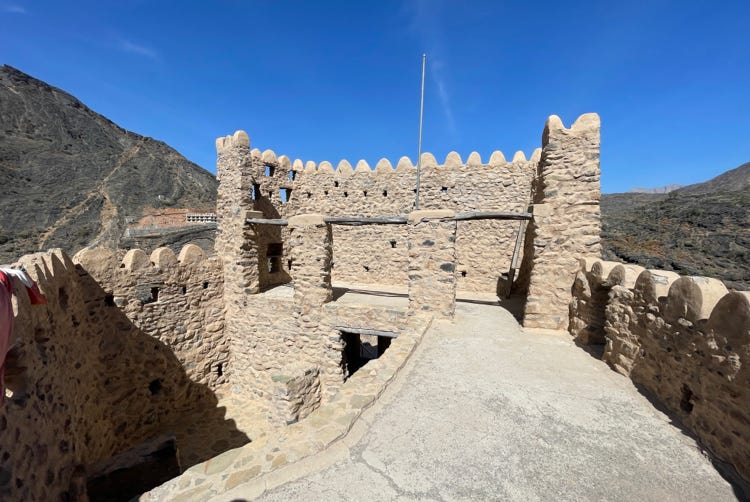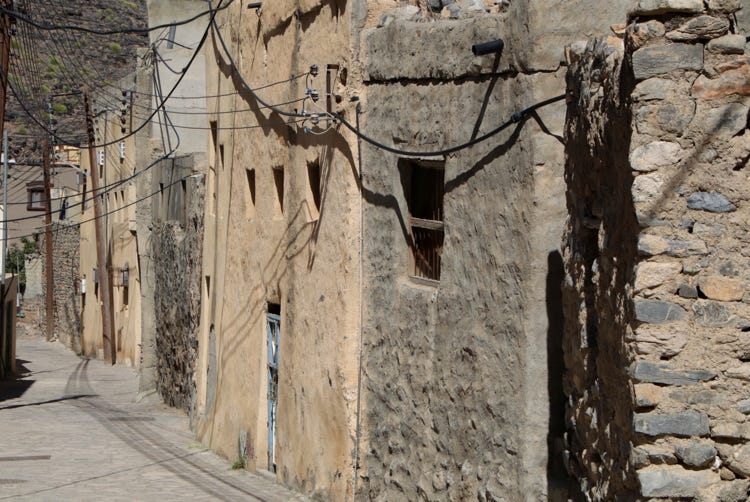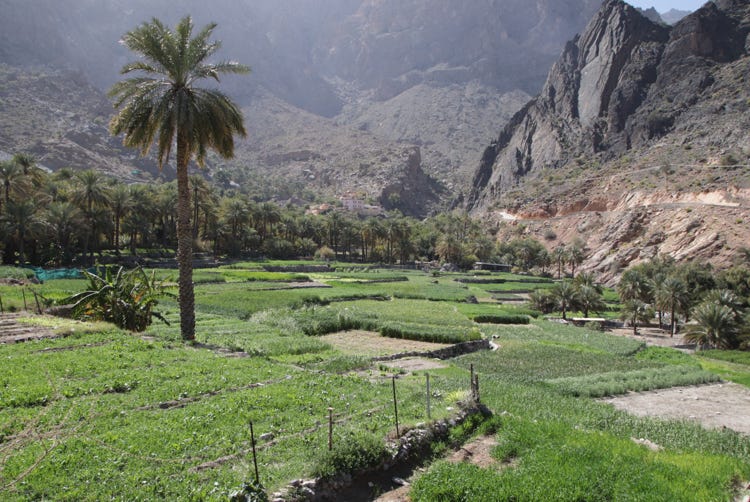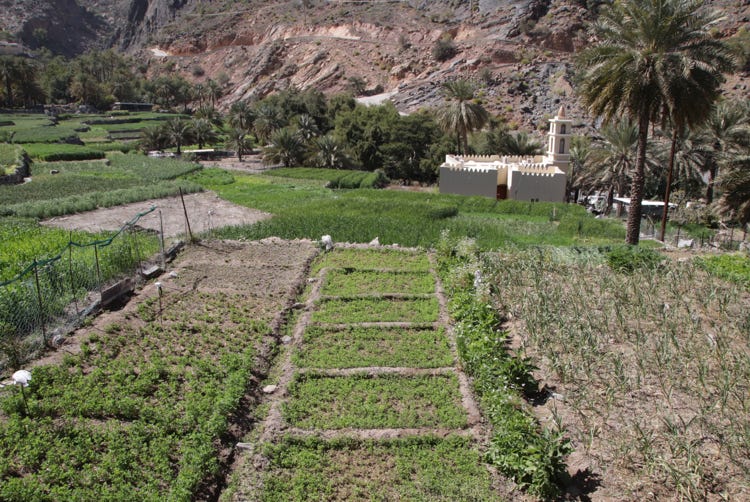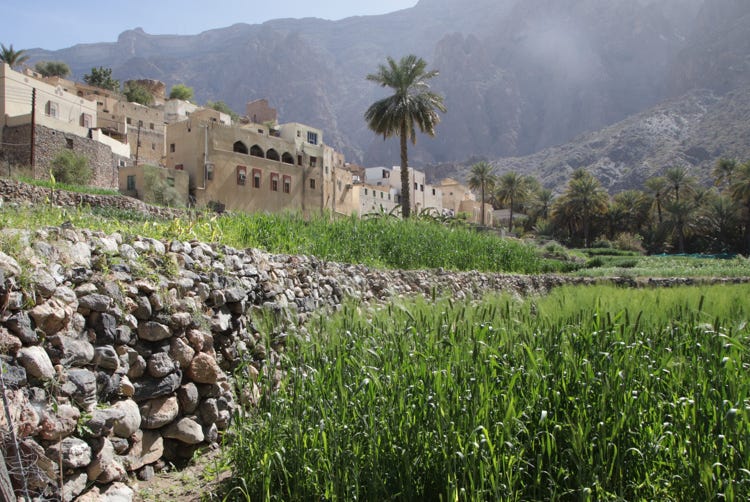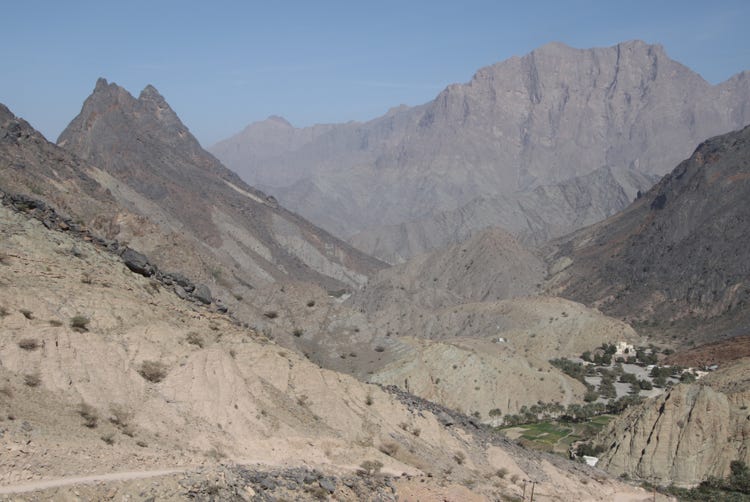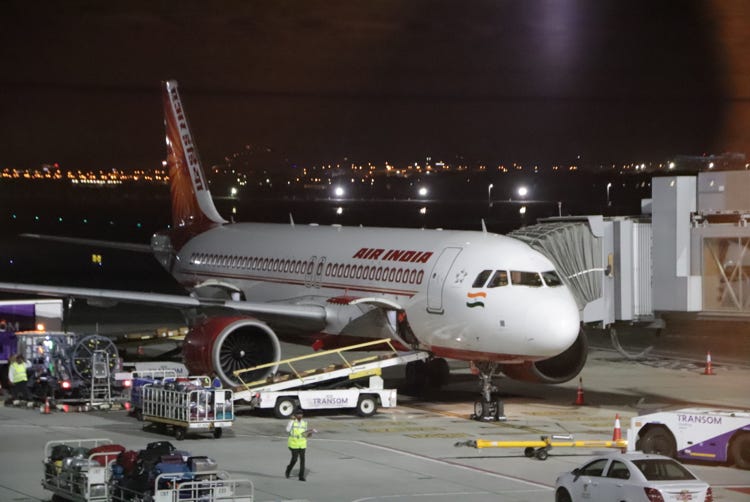I woke up this morning to the competing sounds of roosters crowing and the pre-dawn call to prayer from the minaret of the mosque across the valley. My room in the guesthouse with its cave-like mud-rendered walls sitting atop the main rock in Misfah al Abriyyin was a very special place to spend the night.
Breakfast was also quite special, with lovely fresh locally grown fruits and vegetables, with a special treat of home-baked flatbread topped with homemade date syrup. Enjoying this breakfast while looking across the village to the hills and valleys beyond was a perfect way to start the day.
At 9:00am, the owner of the guesthouse (Abdullah) invited those guests who were interested to join him on a tour through a small museum he has created in his childhood home (that was owned by his grandfather) adjacent to the guesthouse. With a family of four from France, a couple from Poland and a couple from Germany – plus me – we took about an hour to look through the museum that is clearly a labour of love for Abdullah.
He showed all kinds of bric-a-brac that he has collected in the village over the years, and presented it in a highly informative way that gave a great insight into the village’s history from its Persian occupation about 2,500 years ago, through to its evolution from a nearby abandoned settlement to its present site, initially as a walled village with six easily defended gates, up to the present day. He pointed out the old Persian watchtower, the newer ‘star clock’ across the valley, and as a highlight, offered us the chance to wear traditional Omani formal wear (note I participated in this not as cultural appropriation but to honour my very gracious, enthusiastic and highly hospitable host).
I had to take a work-related Zoom call to Australia at 10:00am, so it was almost 11:00am by the time I was ready to begin the day’s drive. My main task (if ‘task’ is the right word) today was to cross the Hajar Mountains from Misfah al Abriyyin and reach Muscat Airport in plenty of time to catch my flight to Delhi, the first leg of my flight home to Australia. According to Google Maps, the total distance of that drive (including one planned short diversion) was 203 kilometres with an estimated driving time of 4 hours 15 minutes. Of course, I intended to take longer than that by stopping to get photos and making one longer stop (my ‘diversion’). Even so, that was plenty of time as my flight to Delhi wasn’t due to depart until 10:25pm (and was subsequently delayed until 10:55pm).
The rugged mountains that I had to cross were part of the Hajar Mountain range (“Hajar” means ‘rocky’ or ‘stone’). The Hajar Mountains are the highest mountain range in the eastern Arabian peninsula, topping out at Oman’s highest peak, Jebel Sham, at 3,028 metres, almost half as high again as Australia’s highest mountain, Mount Kosciuszko.
The road from Misfah al Abriyyin to the highest point of the mountain pass near Jebel Sham is sealed, but still requires slow and careful driving because it is fairly narrow and full of twists and turns. From the watershed point that offers the view of Jebel Sham the road becomes unsealed and is so narrow, twisting, rocky and hazardous that it can only be negotiated with a 4-wheel drive vehicle (which of course I was driving). The 4WD section extends for a distance of just 26 kilometres, but the standard driving time (without stops) for that section is an hour and a half – or an average speed of 17 kilometres per hour. No car I saw today approached such a fast speed on the 4WD section of the road.
I made lots of roadside stops to get photos of the spectacular scenery, but the real highlight of the drive was the extended stop I made at Bilad Sayt (also known as Bald Sayt), located just a couple of slow kilometres to the west of the main mountain “road”.
Situated on a large rocky outcrop that was largely surrounded by verdant green terraced farmland, Bilad Sayt rose majestically from the low land immediately around it despite being completely dominated by the massive backdrop of the mountains in every direction. I parked my car just outside the town because most of the roads were far too narrow to fit a vehicle, and I made my way up the main hill. I was soon surrounded by young boys who were very interested in the visitor.
One boy (or more properly, “youth’, as he would have been 14 or 15 years old) was actually very helpful despite his very limited English. He kept beckoning and led me up through a narrow network of laneways and stairs to the old fort right at the top of the town. He knew how to open the locked door (i.e. he had a key) and so I managed to get perfect views of the town in every direction, all the while trying to hold a very limited conversation about iPhones; I had one, he had one, he wanted a better one and wanted to know how much they cost. He offered to swap his iPhone 11 for my iPhone 12 (with a huge smile on his face), but I politely declined.
I continued my drive towards the north, but after Bilad Sayt everything else was something of an anticlimax – though still awe-inspiring for its massive scale. With just a few more photo stops and a fuel stop to fill the tank, I arrived at the airport to return my rental car just after 4:30pm – comfortable time as it was due back by 6:30pm.
I have had quite a few problems with rental cars in Oman, but returning my car today was the most egregious experience of all. The representative of the company, Dollar Rental cars, insisted that the fuel tank was not full (it was, and I have a photo to prove it), and he claimed the car was unacceptably dirty (there was some dust from the dirt road, but a gentle blow was enough to remove it). He insisted I should have gone to a car wash before returning the car as they expected it to be returned in the same immaculate state they delivered it to me. I showed him the photo showing the full fuel tank, and he said he had a photo showing it was just below full (maybe he took the photo at an angle?).
To make a long story short, they insisted on charging me 10 rials (about Aust$37.50) to have the car washed professionally and to cover top-up fuel – at a cost of 0.229 rials per litre, which is about 85 cents Australian, they could probably fill the tank three times over for that amount). If I didn’t agree to this charge, they would withhold refunding the 125 rials (about Aust$470) “pre-authorisation for possible damage” bond deposit I had to pay when I collected the car. I can handle well-meaning incompetence, and I had experienced some with Avis in Oman, but Dollar’s action was unashamed, intentional extortion. Needless to say, I won’t be using that company again. It was the one and only example I experienced of anything approaching dishonesty in Oman, and it’s a pity that it was my final experience leaving the country.
I had to take two flights to return to Australia. The first leg was from Muscat to Delhi on an Air India Airbus A320neo, flight AI974, registration VT-EXV. Scheduled to take off at 10:50pm and land at 3:20am, it departed 10 minutes early at 10:40pm and landed in Delhi 40 minutes early at 2:40am - which was just as well because it took almost an hour to clear security and get to my room in the Holiday Inn Express that is inside the terminal building.
It had been a very long day and I was ready for a sleep to prepare for my second (and final) flight for this trip back to Sydney. I did manage to get a few hours sleep in Delhi before boarding the plane for the final 10,500 kilometre sector to Sydney, an Air India Boeing 787-8, registration VT-ANE, on flight AI302., which touched down in Sydney at 8:45am on Thursday morning 9th February.
